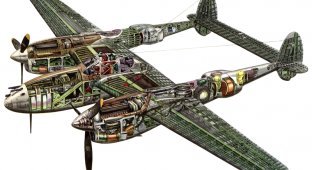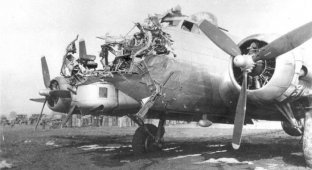So, exactly 35 years ago, the strategic bomber TU-160, also known as the “White Swan,” made its first flight. Let's get acquainted with the difficult fate of this car.

Tu-160 (factory designation: “product 70”, according to NATO codification: Blackjack - “Blackjack”) is a supersonic strategic missile-carrying bomber with a variable-sweep wing, developed at the Tupolev Design Bureau in the 1970s-1980s.
It is the largest and most powerful supersonic aircraft and aircraft with variable wing geometry in the history of military aviation, as well as the heaviest combat aircraft in the world, having the highest maximum take-off weight among bombers. It is also the fastest bomber in service. Among the pilots he received the nickname “White Swan”.

Design
Integrated circuit airframe, differential all-moving stabilizer and all-moving upper fin. Two payload compartments are located in tandem (one behind the other). The main materials of the airframe are titanium - OT-4 alloy (the central supporting beam of the fuselage is 12.4 m long and 2.1 m wide, only up to 20% of the airframe mass), heat-treated aluminum alloys V-95-T2, AK-4 and VT-6, steel alloys and composite materials (approx. 3% of the structure’s mass). The aircraft's hydraulic systems use the main oil IP-50, a 4-channel system with a working pressure of 280 kg/sq.cm. The plane is equipped with a toilet, kitchen, and sleeping area. A radio-absorbing coating is applied to the entrances of the engine air intakes (graphite) and to the nose of the aircraft (special organic-based paint), the glazing is made with mesh filters, and the engines are shielded. The aircraft is equipped with a hose-cone type refueling system receiving device. In serial production, airframe components were produced - wings and engine compartments - Voronezh Aircraft Plant, tail and air intakes - Irkutsk Aircraft Plant, chassis - Kuibyshev Module Plant, fuselage. center section and wing rotation units - Kazan aircraft plant.
Monoblock caissons assembled from monolithic panels and profiles 20 m long were widely used in the wing design. The fuselage was assembled from large-sized sheets, profiles and stampings using special riveting. Control units and wing mechanization (stabilizer, fin, flaperons, flaps, etc.) were manufactured with extensive use of composite and metal glued panels with honeycomb core.

Tests
On December 18, 1981, the first experimental aircraft, piloted by a crew under the command of B.I. Veremey (co-pilot - S.T. Agapov, navigators - M.M. Kozel and A.V. Eremenko) took off for the first time from the airfield in Zhukovsky. The flight took place on the eve of the 75th anniversary of the leader of the Soviet state L.I. Brezhnev. This fact was perceived by everyone as a gift from the OKB to them. A.N. Tupolev and the entire aviation industry to the hero of the day.
From the moment of the first flight of the experimental Tu-160, the stage of flight design (factory) tests began. B.I. Veremey flew especially a lot in the car, for whom the Tu-160, as he later said, became a “native” aircraft (in total, Veremey made more than 600 flights on this type of missile carrier and flew more than 2000 hours; in 1984 he "for the development of new military equipment" he was awarded the title of Hero of the Soviet Union). Here's what Boris Ivanovich said about the first flight and subsequent tests:


In 1984, the Tu-160 was put into serial production at the Kazan Aviation Plant. The first production vehicle (No. 1-01) took off on October 10, 1984, the second production vehicle (No. 1-02) on March 16, 1985, the third (No. 2-01) on December 25, 1985, the fourth (No. 2-02) ) - August 15, 1986.
NATO assigned the preliminary designation "RAM-P", and later the aircraft was given a new code name - "Blackjack". Since that time, US space intelligence services have continuously monitored the progress of testing the new Soviet bomber. Its appearance prompted the US government to speed up work on the B-1B aircraft and accelerated its serial production.
Soon the Western press published a photograph of the new Soviet bomber. Some comments stated that the plane was deliberately, for propaganda purposes, exposed to the lenses of American reconnaissance satellites, while it was assumed that the image was taken from space. In fact, as it later turned out, the published photograph was taken by one of the passengers of a civilian plane landing at the nearby Bykovo airfield.
Externally, the Tu-160 bomber seemed very similar to the American B-1, despite the difference in size. But a number of features indicated different concepts adopted in the design of these machines. The B-1, for example, at the insistence of the US Air Force, abandoned adjustable air intakes, which provided a smaller effective surface area for radio beam dispersion. And although the plane was formally considered supersonic and could reach speeds corresponding to the number M = 1.2 at high altitudes. from the point of view of combat use, this flight mode could not be considered optimal. In turn, the multi-mode adjustable air intakes of the Tu-160, combined with powerful engines and a high aspect ratio fuselage with a relatively small midsection, made it possible to reach speeds of up to 2,200 km/h (this speed was subsequently achieved in one of the test flights). The successful layout of the fuselage also contributed to the reduction in aerodynamic drag. The cockpit on the Soviet bomber was located in front of the nose landing gear compartment, and not above it. The maximum height of the Tu-160 fuselage was no greater than that of the medium Tu-22MZ bomber, which had significantly smaller dimensions. The designers managed to reduce aerodynamic drag due to the strong sharpening of the forward part of the fuselage, as well as the large bevel of the cockpit windshield.

The Soviet Tu-160 production program, like the corresponding American program, envisaged the production of about a hundred vehicles, but a decrease in defense allocations in the second half of the 80s, and then the collapse of the Soviet Union, led to its complete curtailment. By the beginning of the 90s, KAPO built 34 Tu-160 aircraft, including airframes for endurance and strength tests. The 184th Guards TBAP in Priluki received 19 production vehicles, from which two squadrons were formed. Of the total number of aircraft produced, one, as mentioned in the previous chapter, was lost in a plane crash in the spring of 1987; several aircraft, including the first experimental ones, were used by MMZ "Experience" for work on various bomber improvement programs.
In the second half of the 90s, the President of the Russian Federation B.N. Yeltsin decided to resume serial production of the Tu-160 with the aim of introducing into service a fully equipped regiment of bombers of this type. On December 23, 1997, the penultimate of two unfinished aircraft standing in the workshop (No. 8-02) made its first flight from the KAPO airfield in Kazan. After a short cycle of acceptance tests, it joined the group of strategic bombers based in Engels.

Armament
1) 12 x AS-15 (X-55 / X-55SM) on two MKU-6-5U - basic version of weapons, state tests of the system - 1989 (main version - X-55SM, adopted by the Air Force in 1986) . By 2005, some aircraft were converted to use Kh-555 missiles (for example, Tu-160 "Pavel Taran", probably also "Alexander Golovanov" and "Alexander Molodchiy").
2) 12 x AS-16 (X-15) on two MKU-6-5U (NOT IMPLEMENTED in real combat units)
During the modernization process, following the model of the 2006 model, the range of weapons will include the X-555, X-101 and X-102 CRBDs, AS-16 (X-15) aeroballistic missiles, conventional free-fall bombs and UAB.
The aircraft's weapons systems and weapon use schemes were developed jointly with GosNIIAS. From the Tupolev Design Bureau, the creation of the weapons complex was supervised by L.N. Bazenkov. The main weapons of destruction (KRDB) were developed by the Raduga design bureau by A.Ya. Bereznyak (chief designer I.S. Seleznev).
The bomb armament of the Tu-160 is considered as a “second-stage” weapon, intended to destroy targets that remained after the first missile strike of the bomber. It is also located in weapons bays and can include adjustable bombs of various types, including the most powerful domestic ammunition of this class, the KAB-1500 series with a caliber of 1500 kg. The aircraft can also be equipped with free-falling bombs (up to 40,000 kg) of various calibers (including nuclear), disposable cluster bombs, sea mines and other weapons. In the future, the bomber's armament is planned to be significantly strengthened by introducing high-precision cruise missiles of a new generation (X-555 and X-101), which have an increased range and are designed to destroy both strategic and tactical ground and sea targets of almost all classes.


Equipment
The main developer of avionics is the Elektroavtomatika Research Institute (Leningrad, chief designer - E.S. Lipin).
The Tu-160 sighting and navigation system includes an astroinertial two-channel navigation system K-042K, an automatic terrain following system, a GLONASS satellite navigation system (accuracy up to 10-20 m, a modified system produced by the Compass IKB will be installed starting in 2007 for all aircraft during modernization) and a multi-channel digital communications complex. In total, more than 100 on-board computers are involved in the aircraft systems, incl. The navigator has 8 digital computers and a PA-3 plotting tablet (with a moving map, probably digital?). The cockpit is equipped with a standard set of equipment with traditional displays and dials of the Tu-22M3 type. Instead of a steering wheel, a control stick (joystick) similar to a fighter is used.
The Obzor-K sighting and navigation system will include the Poisk bombing and navigation radar (the detection range of large radio-contrast targets from high altitudes is 600 km or more) and the OPB-15T Groza optical-electronic bomber sight (daytime bombing , or bombing in low light conditions, T - probably "television"). During the modernization, the aircraft can receive a laser target designator for the use of adjustable aerial bombs with laser seekers from high altitudes. Missile control system "Sprut-SM" (introducing target designation into the seeker of missiles before launch, ensuring the use of CRBD).
The aircraft's radar signature was reduced by additional measures such as applying special organic-based paint to the nose, graphite radar-absorbing black film on the air intakes and air ducts, shielding some engine components, and introducing mesh anti-radar filters into the cockpit glazing. Some of these activities were carried out in combat units.
The Baikal airborne defense system detects and classifies any enemy radar, thermal targets (the Ogonyok heat direction finder is located at the rearmost point of the fuselage) and ensures the use of active electronic warfare equipment, passive submarines and IR decoys (electronic warfare equipment is located in the tail cone ). Improvements to the BKO were completed in April 1990.
Air refueling system. Ejection seats K-36DM developed by NPO Zvezda (chief designer G.I. Severin) with backrests equipped with cushions with pulsating air (in the process of mass production). The ejection system is individual and forced for the entire crew (launch from any workplace). Ejection is possible in the “0-0” mode (zero speed, zero altitude) - after modifications during the development process (initially - the minimum ejection speed is 75 km/h). When performing high-altitude flights, the crew uses high-altitude Baklan space suits (only prototypes exist - according to Butovsky, 1995). In standard modes - protective helmet ZSh-7B or ZSh-7AS.



Performance characteristics of the Tu-160
Dimensions: maximum wingspan - 55.7 m, minimum - 35.6 m, length - 54.1 m, height - 13.2 m.
Wing area – 360.0 sq. m.
Aircraft weight, kg.
- empty – 110,000
- normal take-off – 267,600
- maximum take-off – 275,000
Engine type – 4 NK-32 turbofan engines, non-afterburning thrust – 4x137.2 kN, afterburning – 4x247.5 kN.
Maximum speed at altitude is 2230 km/h, cruising speed is 917 km/h.
Practical flight range without refueling: 12,300 km.
Combat radius: 6,000 km.
Practical ceiling – 15,000 m.
Crew – 4 people

Exploitation
The first two Tu-160 aircraft (No. 1-01 and No. 1-02) entered the 184th Guards Heavy Bomber Aviation Regiment in Priluki (Ukrainian SSR) in April 1987. At the same time, the aircraft were transferred to the combat unit before the completion of state tests, which was due to the rapid pace of introduction of American B-1 bombers into service.
By 1991, 19 aircraft arrived in Priluki, of which two squadrons were formed. After the collapse of the Soviet Union, they all remained on the territory of independent Ukraine.
In 1992, Russia unilaterally stopped flights of its strategic aviation to remote regions.
In 1998, Ukraine began to destroy its strategic bombers using funds allocated by the United States under the Nunn-Lugar program.



In 1999-2000 an agreement was reached under which Ukraine transferred eight Tu-160s and three Tu-95s to Russia in exchange for writing off part of the gas purchase debt. The remaining Tu-160s in Ukraine were destroyed, except for one machine, which was rendered unfit for combat and is located in the Poltava Museum of Long-Range Aviation.
Airbase "Priluki" aircraft No. 10 and No. 11 return to Russia
Airbase "Priluki" aircraft No. 10 and No. 11 return to Russia
By the beginning of 2001, in accordance with the SALT-2 Treaty, Russia had 15 Tu-160 aircraft in combat service, of which 6 missile carriers were officially armed with strategic cruise missiles.
In 2002, the Ministry of Defense entered into an agreement with KAPO to modernize all 15 Tu-160 aircraft.
On April 22, 2006, the Commander-in-Chief of Long-Range Aviation of the Russian Air Force, Lieutenant General Khvorov, said that during the exercise, a group of modernized Tu-160 aircraft penetrated US airspace and went unnoticed.
On July 5, 2006, the modernized Tu-160 was adopted by the Russian Air Force, which became the 15th aircraft of this type (w/n “19” “Valentin Bliznyuk”). The Tu-160, which was transferred to combat service, was built in 1986, belonged to the Tupolev Design Bureau and was used for testing.
On August 17, 2007, Russia resumed strategic aviation flights in remote regions on a permanent basis.
In July 2008, reports appeared about the possible deployment of Il-78 tankers at airfields in Cuba, Venezuela and Algeria, as well as the possible use of airfields as backup for Tu-160 and Tu-95MS.
On September 10, 2008, two Tu-160 bombers (“Alexander Molodchiy” with no. 07 and “Vasily Senko” with no. 11) flew from their home base in Engels to the Libertador airfield in Venezuela, using the Olenegorsk airfield as a jump-off airfield. in the Murmansk region. Part of the way through Russian territory, the missile-carrying bombers were accompanied (for cover purposes) by Su-27 fighters of the St. Petersburg Air Force and Air Defense Association; while flying over the Norwegian Sea, Russian bombers intercepted two F-16 fighters of the Norwegian Air Force, and two F fighters near Iceland -15 US Air Force. The flight from the stopover site in Olenegorsk to Venezuela took 13 hours. There are no nuclear weapons on board the aircraft, but there are training missiles with the help of which combat use is practiced. This is the first time in the history of the Russian Federation that Long-Range Aviation aircraft have used an airfield located on the territory of a foreign state. In Venezuela, the aircraft carried out training flights over neutral waters in the Atlantic Ocean and the Caribbean Sea. On September 18, 2008, at 10:00 Moscow time (UTC+4), both aircraft took off from the Maiquetia airfield in Caracas, and over the Norwegian Sea, for the first time in recent years, made night refueling in the air from an Il-78 tanker. At 01:16 (Moscow time) on September 19, they landed at the base airfield in Engels, setting a record for flight duration on the Tu-160.
June 10, 2010 — The maximum range flight record was set by two Tu-160 strategic bombers, Vladimir Drik, an official representative of the press service and information department of the Russian Ministry of Defense, told Interfax-AVN on Thursday. The flight duration of the missile carriers exceeded last year's figure by two hours, amounting to 24 hours 24 minutes, while the flight range was 18 thousand kilometers. The maximum volume of fuel during refueling was 50 tons, whereas previously it was 43 tons.
At the beginning of 2013, the Russian Aerospace Forces included 16 Tu-160 aircraft.
In April 2015, Russian Defense Minister Sergei Shoigu ordered the resumption of bomber production. The Russian Air Force will acquire at least 50 Tu-160M bombers. The resumption of production of new aircraft of the Tu-160M / Tu-160M2 classification is expected no earlier than 2023.
On August 12, 2016, at the “I Choose the Sky” festival, held at the Kurkachi airfield (Vysokogorsky district of Tatarstan), the audience was shown the newest Tu-160M (the first in the M line), which should soon be transferred to the Russian Aerospace Forces.
As of August 27, 2016, the still unnamed Tu-160M was undergoing factory flight tests at the Borisoglebskoye airfield of the Kazan Aviation Plant.
In November 2016, the Kazan Aviation Plant began to restore key technologies for the production of the Tu-160 strategic bomber-missile carrier. Earlier, Russian Deputy Defense Minister Yuri Borisov stated that mass production of the vehicles should begin in 2023.
Losses
On September 18, 2003, during a test flight after engine repair, a disaster occurred; the plane with tail number “01” crashed in the Sovetsky district of the Saratov region during landing. The Tu-160 crashed into a deserted place 40 km from the home airfield. There were four crew members on board the vehicle: commander Yuri Deineko, co-pilot Oleg Fedusenko, as well as Grigory Kolchin and Sergei Sukhorukov. They all died.
Combat use
For the first time, Tu-160s were used during the Russian military operation in Syria on November 17, 2015. The strikes were carried out by Kh-555 cruise missiles (a modification of the Kh-55 with a non-nuclear warhead) and Kh-101 against Islamic State targets
Interesting Facts
When US Secretary of Defense Frank Carlucci visited the air base in Kubinka during his visit to the Soviet Union, while trying to enter the cockpit of the Tu-160, he accidentally hit an unsuccessfully located electrical panel (after which the pilots called this element the “Carlucci panel”).
The former commander-in-chief of the Russian Air Force, Army General P.S. Deinekin, who commanded the crew of the flagship that day, recalled: “With the serial production of the strategic Tu-160, Russia once again confirmed its status as a great aviation power and the homeland of heavy aircraft construction. When in the First World War aviators The West bravely chattered in the sky on the Voisins, Blériots, Nieuports and Farmans with one engine, the Russians conquered the front-line skies on four-engine ships with the heroic name Ilya Muromets.
And now just photos and videos of our beauties




































